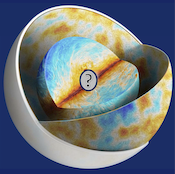Orateur
Description
Spectral Imaging relies on the interferometric nature of a bolometric interferometer: the combination of fringes at the focal plane formed by the aperture array in the pupil plane results in a point spread function for the instrument that exhibits multiple peaks, each with a width corresponding to the angular resolution of the instrument. The angular distance separating the peaks is proportional to wavelength, exactly as in grism spectroscopy. This PSF is known as the synthesized beam.
The signal in each detector is therefore a linear combination of signals from different regions of the sky and different wavelength, in a manner that is perfectly known for an ideal instrument, and can be precisely calibrated through usual calibration, or even further with the interferometry-specific "self-calibration". A Bolometric Interferometer therefore has spectral information encoded in the detector signal, in contrast with a classical imager where this information is averaged out in the bandwidth.
A number of consequences follow that I will describe in this presentation:
- Ability to perform mapmaking into sub-bands within the physical bandwidth, resulting in a higher spectral resolution which allows for precise removal of foreground contamination (foregrounds with spectral features)
- Ability to perform foreground component map-making directly from Time-Ordered-Data with a number of advantages: simpler and more accurate noise modeling, direct account for systematics, better ability to reconstruct emission line foregrounds (eg. CO)
- The possibility of Ultra-Wide-Band focal planes, covering from 90-280 GHz with all detectors receiving photons from all frequencies, therefore increasing throughput by a significant factor with respect to classical imagers where the focal needs to be split into the distinct frequencies.
These feature will soon be tested with QUBIC and, if confirmed, could represent a significant breakthrough in CMB polarimetry.

